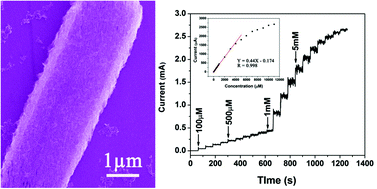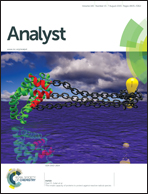Nanoporous copper oxide ribbon assembly of free-standing nanoneedles as biosensors for glucose†
Abstract
Inspired by a sequential hydrolysis–precipitation mechanism, morphology-controllable hierarchical cupric oxide (CuO) nanostructures are facilely fabricated by a green water/ethanol solution-phase transformation of Cux(OH)2x−2(SO4) precursors in the absence of any organic capping agents and without annealing treatment in air. Antlerite Cu3(OH)4(SO4) precursors formed in a low volume ratio between water and ethanol can transform into a two-dimensional (2D) hierarchical nanoporous CuO ribbon assembly of free-standing nanoneedle building blocks and hierarchical nanoneedle-aggregated CuO flowers. Brochantite Cu4(OH)6(SO4) precursors formed in a high volume ratio between water and ethanol can transform into hierarchical nanoplate-aggregated CuO nanoribbons and nanoflowers. Such 2D hierarchical nanoporous CuO ribbons serving as a promising electrode material for nonenzymatic glucose detection show high sensitivity, a low detection limit, fast amperometric response and good selectivity. Significantly, this green water-induced precursor-hydrolysis method might be used to control effectively the growth of other metal oxide micro-/nanostructures.


 Please wait while we load your content...
Please wait while we load your content...